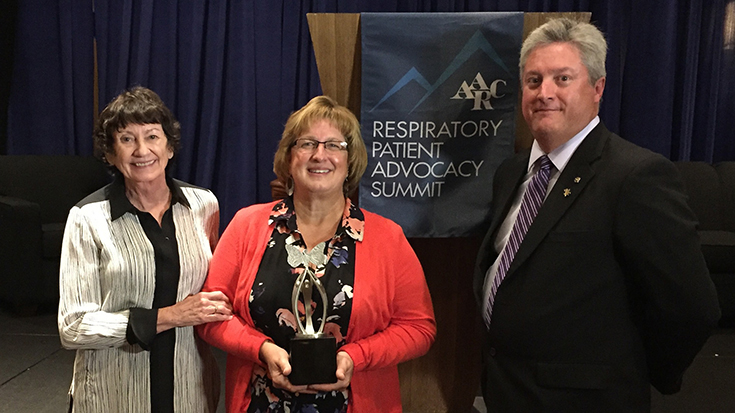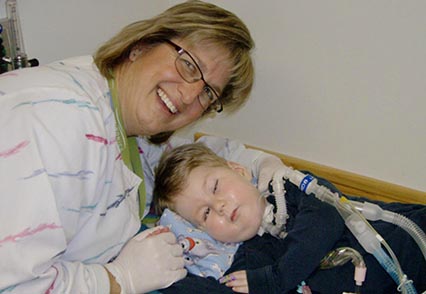
Christine Hartling, MHM, RRT, RRT-NPS, has a motto that has served her well in her work with children who require tracheostomies: These are normal people who just breathe differently. She lives that philosophy every day in her role as the trach vent coordinator for the respiratory care department at Primary Children’s Hospital in Salt Lake City, UT, and it’s a big reason why she was the first recipient of the AARC/FACES Foundation National Respiratory Patient Advocacy Award.
Video: 2017 Patient Advocacy Summit
Top priority

“When I first started as an RT, there were very few children with trachs and vents,” Hartling said. “It was either not offered as a choice, or if it was offered, these children went on to live in the hospital or extended care facilities.”
Resources to support these kids in their own homes were few and far between and she made it her mission to change all that for the better.
“Getting them home became a priority for me,” she said. “To that end, I spent the majority of my career convincing the system that these kids need to be at home, doing all the things kids love to do, being cared for by their families.”
Hartling regularly shares the knowledge she has gained from working with these children with students in respiratory therapy programs, community organizations, home health agencies, school nurses, and the medical students, residents, and fellows who come through her teaching hospital.
She has also traveled overseas with the International Children’s Heart Foundation to support the training of respiratory students in Ghana and is a member of the Global Tracheostomy Collaborative.
It’s been a privilege
But this RT emphasizes she’s happiest in the clinical setting, providing “her kids” in both inpatient and outpatient areas with the care and education they need to go out and lead normal lives despite being dependent on medical technology.
“I have had the privilege of working in the pediatric world for the last 25 years and it is amazing to me how resilient kids are and how they don’t let a ‘little’ thing like being on life support keep them from just being kids,” Hartling said.
Her reward comes from the photos families share of their kids doing all those normal things when they go home.
“One of my greatest joys is that I always ask my discharging families to send me vacation pictures,” she said. “I have pictures of trach vented children riding horses, hot air ballooning, swimming, playing on the beach, and out deer hunting in the snow.”
She says there is nothing better than “helping convince a family that they ‘can.’”
Go to bat for the patient
Hartling believes all respiratory therapists can advocate for their patients too. And it doesn’t have to be showy or dramatic.
“We often think that an ‘advocate’ is somebody storming the capital in Washington, D.C.,” Hartling said. “In reality, an advocate takes time to answer questions, educate on proper breathing techniques, pushes patients forward, does basic therapies to best of their ability and training.”
Going to bat for a patient by asking the medical team if the therapy the patient is receiving is really the most appropriate therapy, or researching better ways of handling a specific issue is advocacy too.
“There will always be time to storm the capital, but there is never enough time to help someone breathe better,” Hartling said.
Learn More About the National Respiratory Patient Advocacy Award